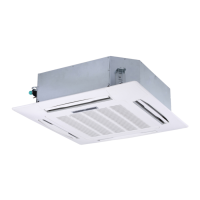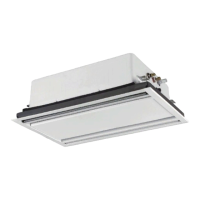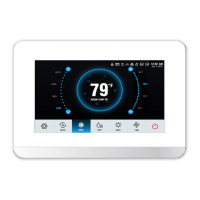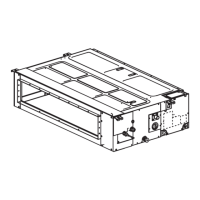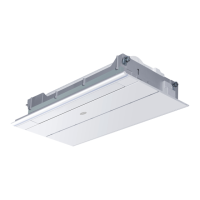7
INSTALLING MOUNTING BRACKET AND MOUNT-ING
UNIT (FLOOR STANDING) — The mounting bracket (see
Fig. 10) can be anchored to the wall with screws. For unit
weight and mounting dimensions, see Table 4.
Fig. 10 —Mounting Bracket Locations
Table 4 —Unit Weight and Mounting Dimensions
(Floor Standing)
The unit can now be lifted and mounted onto the mounting
brackets.
1. Anchor the brackets at the specified location on the wall
using the mounting screws. See Fig. 11.
2. Once the brackets are secured, lift the unit and mount it
on the brackets. Be sure the brackets are engaged in the
correct mounting locations on the back of the unit.
Fig. 11 —Mounting Brackets to Wall
For models 036 and 048 there is an outside air opening on the
back of the unit. See Fig. 12 below.
Fig. 12 —Outside Air Opening Cutout Location
Step 4 — Connect Piping
CONDENSATE PIPING — The unit is supplied with a 5/8-
in. OD drain connection to connect copper or plastic drain
piping. When installing condensate piping, follow these
recommendations:.
• Condensate piping should slope downward in the
direction of condensate flow, with a minimum gradient
of 1 in. per 100 inches.
• When multiple units are connected to a common
condensate drain, ensure that the drain is large enough to
accommodate the volume of condensate from all units. It
is also recommended to have an air vent in the
condensate piping to prevent any air locks.
• Condensate piping must not be installed where it may be
exposed to freezing temperatures.
REFRIGERANT PIPING
When connecting refrigerant piping from an indoor unit to an
outdoor unit, follow these guidelines:
• Check maximum height drop and length of refrigerant
piping between the indoor and outdoor units. If the
difference between them is more than 33 ft, consider
mounting the outdoor unit above indoor unit.
• Refrigerant piping connection between indoor and
outdoor units should be performed once the units are
secured at their respective installation locations.
• The refrigeration piping starts at the indoor unit and ends
at the outdoor unit.
• The number of bends in the refrigeration piping must be
fewer than 15.
• The refrigerant piping should be dry and free of dust and
other impurities.
• The bending angle of the refrigerant pipe should not
exceed 90
° and the bending radius should be as large as
possible to prevent any breakage in piping.
• Use proper cutting and flaring tools to avoid leakage.
• Before insulating the suction and liquid refrigeration
pipes, perform pressure and leak tests. For details, see
the outdoor unit installation manual. Insulating both
suction and liquid refrigerant pipes is required.
• Vacuuming and charging of the system should be carried
out as described in the outdoor unit installation manual.
40VMU UNIT WEIGHT (lb)
DIMENSION (in.)
A B
012 57 17-
7
/
8
19-
7
/
8
015-024 62 17-
7
/
8
19-
7
/
8
030 76 31-
1
/
4
19-
7
/
8
036,048 106 42-
1
/
8
17-
3
/
4
CAUTION
To avoid site damage, be sure there are no water, plumbing,
or electrical lines running through the wall at the mounting
location.
IMPORTANT: Be sure to anchor the brackets on wall
studs.
CAUTION
Cut along the marked dotted line only. Failure to do so may
result in damage to the equipment.
CAUTION
When connecting from an indoor unit to an outdoor unit,
the isolation valve at the outdoor unit should be in the
closed position throughout the refrigerant piping process.
Failure to follow this procedure may result in equipment
damage.
please cut along the marked
For outside air opening,
dotted line.
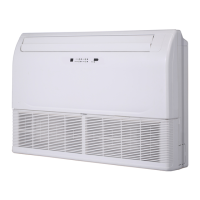
